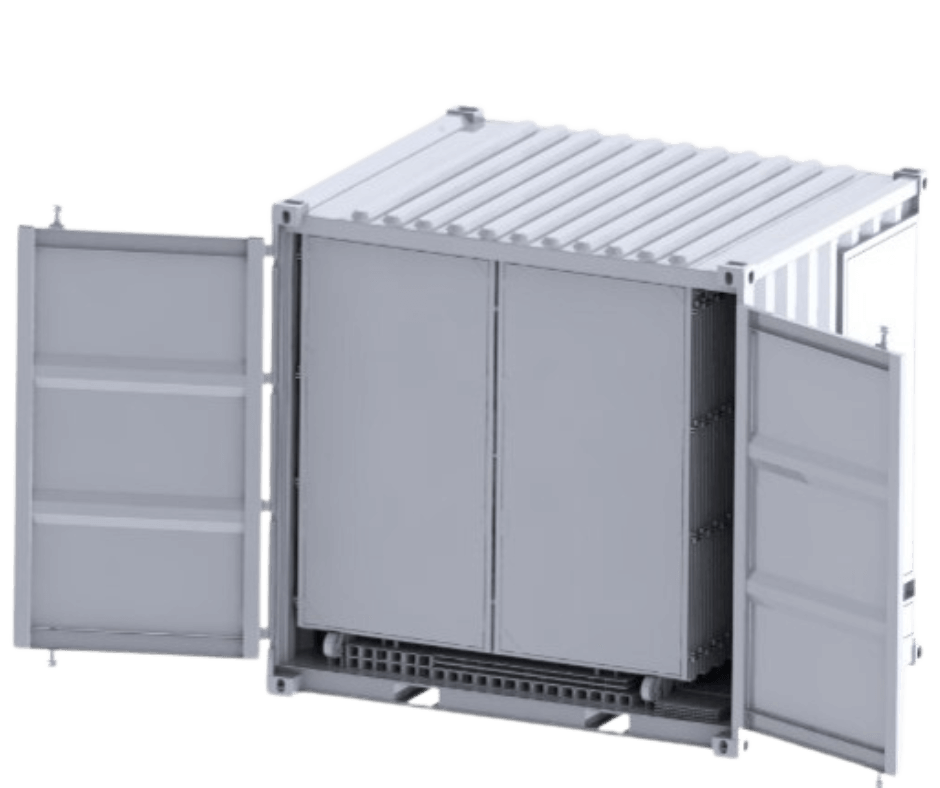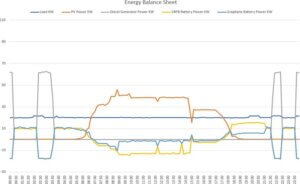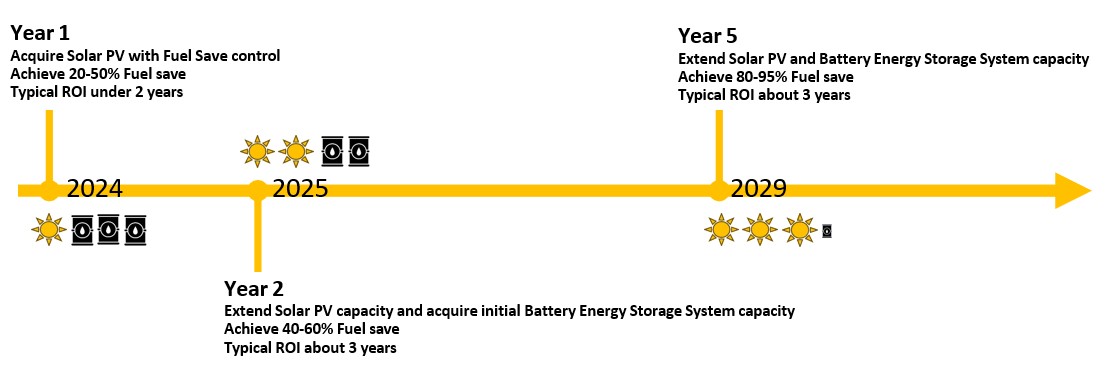
Solar In A Box
Compact, Smart, Containerized Solar Solution
Our containerized energy solution offers notable economic and practical advantages:
- Minimal civil and site work costs, with system setup requiring only open flat ground and no ground penetration
- Plug-and-play architecture ensuring rapid deployment
- Modular containers designed to meet diverse site demands
Renewable energy systems are no longer permanent fixtures; they are now redeployable to cater to your evolving needs. solar arrays can swiftly retract into the container (protection mode) in anticipation of extreme weather conditions, safeguarding against direct damages and potential insurance premiums.
Individually or as a company, there exists a myriad of motivations to embark on a journey toward renewable energy, carbon neutrality, and comprehensive sustainability. It is imperative to thoroughly analyze the underlying reasons and strike a balance between expectations, technological considerations, supply security, and economic factors. Each case presents a unique blend of these elements.
We can provide guidance tailored to facilitate a phased and cost-effective transition to renewable energy sources. Drawing on our extensive industry experience, including the deployment of hundreds of off-grid solutions over the past decade, we have gained insights into contemporary solutions involving solar and battery storage solutions. Click the button below to download our sales sheet.
Click to Download Our Solar In A Box Data Sheet



Why We Designed It
Quick deployment
- The containers just requires flattened land area for deployment
- Initial setup in just a few hours
Low manpower requirements
- Requires 2 regular workers for initial setup
- Plug and play, quick electrical connections
Counter extreme weather
- Pull in time about 30 minutes
- Protects the solar array during storms and typhoons
Temporary deployment
- Ideal for any type of camp or construction site
- Shifting seasonal energy requirements (irrigation and water pumping, harvest and more)
Provide or Strengthen energy infrastructure
- Ideal first deployment for rural electrification
- Ideal element for a Distributed Energy Resource (DER) structure
- Modularity to meet any current and future requirement

Distributed Energy Resources (DER)
MESH NETWORK: In areas with no utility supply, limited utility supply, or frequent outages, employing the Distributed Energy Resources (DER) and MESH grid principle is the recommended long-term strategy; the advantages are many.
REDUNDANCY: A distributed infrastructure has no single point of failure when deployed in clusters, and combined with mesh-type interconnection, the level of area/total plant redundancy and secure energy supply increases to close to 100%
MODULAR & EXPANDABLE:
- The modular nature of a DER also allows for multi-stage deployments, firstly deploying the partial asset, giving the most immediate value considering the local conditions and eventually leading to a greener and more economical energy supply over time.
- Modular staged deployment allows for sensible economics regarding CapEx/ROI and re-investment of the savings into increased renewable and redundant energy infrastructure.
- We provide interoperability and expansion of the energy infrastructure and replace or strengthen it over time.
UNINTERRUPTED POWER SUPPLY: act as an Uninterrupted Power Supply (UPS), protecting and securing mission-critical processes, saving high downtime costs and equipment replacement.
Coming together, the proven technology elements represent todays most ideal energy solutions for D.E.R. deployments in the world’s most challenging environments.


Product Range
Standardized Solar PV Energy Containers
-
10’ Container 60KWP (Q3-2024)
-
20’ Container 120KWP (Q4-2024)
Add-ons, Control functions & accessories:
-
Motorized pull out/pull in accessory
-
Additional wind secure accessories
-
Battery Energy Storage containers (Build to order)
-
Pre-integrated Diesel Generators (Build to order)
-
Fuel Save Controller
-
Energy Arbitrage Controller
-
Virtual Power Plant Operator interface
-
Utility/Grid Operator interface
-
Blockchain based billing system

Live Demonstration, AMC Henderson, Perth, WA


Demonstration System Elements
PV Solar Energy Container
- Fast deployable, retractable and re-deployable Solar Power
- Initial set up in 4-5 hours
- 110 kWP power delivering up to 100kW 3-phase output
- Typical average daily yield in Western Australia 528 kWh (June 358kWh/November 675 kWh)
- Operates directly with diesel generators
- Operates in a full hybrid system with energy storage and multiple generation sources
Vanadium Redox Flow Battery (Main Storage)
- 40kW power/200kWh stored energy
- Service life 20,000 cycles or minimum 20 years
- No requirements for climate control in ambient temperatures under 50 Celsius
- High re-purpose-value at end of life
- Non-flammable
Super Capacitor Batteries (Peak Demand)
- 73kW power/37.5kWh stored energy
- Service life up to 20,000 cycles or 20 years
- No requirements for climate control in ambient temperatures under 40 Celsius
- Non-flammable
Advanced Energy Management System (A-EMS)
- Operates a full hybrid system with two types of energy storage and multiple generation sources
- Primary Renewable Energy Supply with Diesel back up
- Baseload 24 hour from battery / solar power with supplementary Diesel Generator
- Fuel saving on Diesel Generator
- Peak Demand/Peak Shaving
- Grid-stabilization, Quick response, Frequency regulation (not demonstrated at Henderson, WA)




Demonstration Objectives
PV Solar Fuel Saving
- Diesel generator supplies baseload
- Controls the Diesel generator to operate at its minimum capacity, considering spinning reserve (Typical 20-30% Capacity)
- Utilizes solar energy to supply 25-70% direct operational load in daylight hours
- Solar supplies 20-50% of total energy requirements
Full Hybrid System Operation
- Batteries supply baseload
- Utilize the full generation capacity of solar energy
- VRFB stores solar energy for nighttime usage
- Super Capacitor Batteries supplies high load demands
- Diesel Generator runs on back up demand
- Solar / batteries supplies 50-90% of total energy requirements

Field Test – Fuel Save with Solar Only
Test System Hardware
- 200 kVa Diesel Generator
- 110 kWP Solar PV power container
- Fuel Save controller
Test Conditions – 24 hour snapshot
- Typical work site load scenario.
- Low and steady 14 kW “idle” off work load activity at night hours
- Mixed high load activity during work hours 50-100 kW
Test Objective
- To prove the relationship of controlled power generation from the solar array while maintaining spinning reserve of the baseload diesel generator.
- Diesel generator fuel savings during high activity workday
Test Results and Economic Takeaways



Field Test – 24 Hour Solar/Batteries, Low Sun

Test results and Economic Takeaways


Test System Hardware
- 200 kVa Diesel Generator
- 110 kWP Solar PV power container
- 37.5 kWh Graphene Super Capacitor Bank
- 40 kW/200 kWh Vanadium Redox Flow Battery
- 72 kW Max power from Battery systems
- Advanced Energy Management System
Test Conditions – 24 hour snapshot
- Typical automated facility (e.g. water pumping station) or worksite with automated basic system operation in weekend or holiday period
- Constant load of 20 kW for 24 hours
Test Objective
- 24 hours autonomous energy system operation
- Simulating a day with low sun irradiation
- The operation of 2 battery types in workload share mode
- Use of Diesel Generator in intervals to supply load and charge batteries at night

Field Test – 24 Hour Solar/Batteries High Variable Loads
Test System Hardware
- 200 kVa Diesel Generator
- 110 kWP Solar PV power container
- 37.5 kWh Graphene Super Capacitor Bank
- 40 kW/200 kWh Vanadium Redox Flow Battery
- 72 kW Max power from Battery systems
- Advanced Energy Management System
Test Conditions – 24 hour snapshot
- Normal industrial facility with high daytime activity and low nighttime activity
- Daytime loads from 48 to 65 kW
- Nighttime/idle load 14 kW
Test Objective
- 24 hours autonomous energy system operation
- The operation of 2 battery types in workload share mode
- The capability to meet high daytime loads
- The maximum performance of the PV system
Test results and Economic Takeaways



Field Test – 24 Hour Operation Solar / Battery Only
Test results and Economic Takeaways



Test System Hardware
- 200 kVa Diesel Generator
- 110 kWP Solar PV power container
- 40 kW/200 kWh Vanadium Redox Flow Battery
- 36 kW Max power from Battery systems
- Advanced Energy Management System
Test Conditions – 24 hour snapshot
- Normal industrial facility (e.g. a farm) with higher daytime activity and lower nighttime activity
- Daytime loads from 12 to 24 kW
- Nighttime/idle load 7 kW
Test Purpose
- 24 hours autonomous energy system operation
- The capability to operate without Diesel Generator
- The capability to sufficiently charge the VRFB battery bank for nighttime operation


Field Case Example
Isolated Mining process, Democratic Republic of Congo
- 3900KWP Solar Capacity
- (33×20’ HQ Fold Out containers)
- 2400 kW/ 7308 kWh battery capacity
- 5×20’ HQ containers
- 3x1250kW Decentralized Diesel Generator Plant
- Self Supply 24/7/365
- Support/stabilize local grid
- 65% Renewable energy supply
- Levelized Cost of green electricity 0,16 USD/kWh

The Sensible Transition from Fossil Based to Renewable Energy
The demonstration illustrates a favorable return on investment (ROI) across various usage scenarios, considering the ongoing upward trend in fuel costs. The prudent decision is to initiate a transition towards fuel and carbon emissions savings through an economically and sustainably viable method. When the decision to transition is primarily driven by economic considerations, the optimal approach involves implementing a standard 5-year transition plan.

Click to Download Our Full Case Study
Ready to start your project?
Contact us to start with a demo unit for your needs at sales@mintenergy.com

